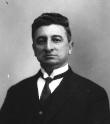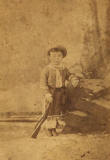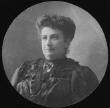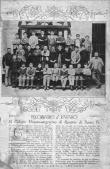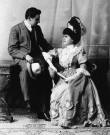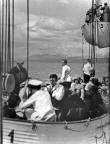
click pictures to see details / haga click en las imágenes para verlas ampliadas
Photographer and painter. He was born at Gualeguay, Entre Rios province, Argentina, on June 27, 1878. He studied at Hispanoargentino College in Rosario and National College in the same city. He was the son of Evaristo Germán Bustos and Clara Perotti, first telegraphist woman in Argentina.
Fotógrafo y artista plástico nacido en Gualeguay, provincia de Entre Ríos, Argentina, el 27 de junio de 1877. Cursó estudios en el Colegio Hispanoargentino de Rosario y en el Colegio Nacional de la misma ciudad. Era hijo de Evaristo Germán Bustos y de Clara Perotti, primera mujer telegrafista del país.
|
Carlos Bustos 1880
Foto Chute & Brooks |
Clara Perotti
First telegraphist woman in Argentina
Primera mujer telegrafista de Argentina
|
Hispanoargentine College group
Grupo del Colegio Hispanoargentino |
In 1895 he settled in San Nicolas, Buenos Aires province, where his father was the head of the Post Office. There, he seconded him in the direction of a telephonic network and an electric plant owned and installed by him. In that year he started also as a photographer at 179 Nacion St., and later he worked for a short period at the National Custom Administration (1896 to 1897)
En 1895 se radicó en San Nicolás, provincia de Buenos Aires, donde su padre actuaba como jefe de Correo, para secundarlo en la dirección de una empresa telefónica y una usina eléctrica particular que éste había instalado. En aquel año comenzó a trabajar también como fotógrafo en calle Nación 179 y poco después tuvo una breve actuación en la Aduana (1896 a 1897).
 Evaristo Germán Bustos |
 Correo y casa de fotografía, luego propiedad de Hardy Post office and photographic studio, later owned by Hardy |
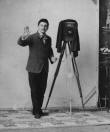 Carlos Bustos y su cámara Carlos Bustos and his camera |
Being only twenty years old, in 1898, he became a photographic reporter from "Caras y Caretas", since the foundation of that renowned argentine magazine from Buenos Aires. This way he witnessed important historic moments and recorded them with his camera, facts such as the President Julio Roca's official visit to Brasil, the brasilian president Campos Salles' presence in Argentina, the 1902 Navy Manœuvres, etc. Besides, he could make new ackquaintances among colleagues from all over the world, whith whom he shared his passion for the arts and the advanced technology the photography was in those years.
Contando con sólo veinte años de edad, en 1898, se convirtió en reportero gráfico de "Caras y Caretas", desde el mismo momento de la fundación de aquella prestigiosa revista de Buenos Aires. Esto le permitió ser testigo de importantes momentos históricos, y registrarlos con su cámara, como la visita oficial del Presidente Roca al Brasil, la presencia en Argentina del presidente brasileño Campos Salles, las maniobras navales de 1902, etc. Además le posibilitó el vincularse con colegas de diversas partes del mundo con los que compartía su pasión por el arte y la técnica de avanzada que significaba la fotografía por aquellos años.
In 1902 he was designated Professor of Photography, with the degree of ensign, on the Argentine Army's frigate "Sarmiento", when she made her 3rd. trip throughout the world seas (1902/1903 period). Besides the official charge on the school ship, he acted as a special reporter from the magazine "Caras y Caretas", and his travel letters were regularly published in the newspaper "El Norte de Buenos Aires", from San Nicolas.
En 1902 fue designado Profesor de Fotografía, asimilado con el grado de alférez a bordo de la Fragata Sarmiento de la Armada Argentina, en su tercer viaje por los mares del mundo durante el período de 1902/1903. Además del cargo oficial que desempeñaba a bordo del buque escuela, viajaba como enviado especial de la sus cartas de viaje eran publicadas regularmente en el diario "El Norte de Buenos Aires", de San Nicolás.
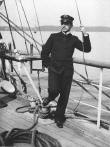 Carlos Bustos a bordo / on board |
 La fragata Sarmiento en San Petersburgo The frigate Sarmiento at St. Petersburg |
 El zar Nicolás II en la Sarmiento The czar Nicolas II on the Sarmiento |
Back in Argentina, he married Paulina Corbetto, and worked briefly at the "Obras Publicas del Río de la Plata" company, San Nicolas Port Power Plant, living in the building where later established the Coast Guard. On March 16, 1907, he became professor of Drawing at the National College, duty performed until his death.
De vuelta en Argentina, se casó con Paulina Corbetto y trabajó brevemente en la Compañía Obras Públicas del Río de la Plata, Usina Puerto San Nicolás, viviendo temporariamente en el edificio donde luego se instaló la Prefectura. El 16 de marzo de 1907 fue nombrado profesor de dibujo en el Colegio Nacional, cargo que ejerció hasta su muerte.
But his main activity was Photography, establishing his own studio at 179 Mitre St., and later at 122/4 Nacion St, with a gallery that became an important point of attraction in San Nicolas. This artistic industry transcended his death on the hands of his sons, Carlos Nicanor and Cesar Carlos.
Pero su principal actividad fue la fotografía, siendo fundador de un negocio del ramo, instalado en Mitre 179 y luego en Nación 122/4, con una galería que llegó a formar parte del paseo obligado de los nicoleños. Esta actividad artística trascendió su muerte en manos de sus hijos, Carlos Nicanor y César Carlos.
|
Carlos Bustos en su estudio / in his studio |
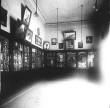 Galería Bustos / Bustos Gallery |
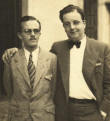 Carlos y César |
He was one of the founders of a Journalists Club in San Nicolas, on March 7, 1913, always as a correspondent of “Caras y Caretas” from Buenos Aires, magazine that regularly published the images sent by him, covering the local social activity. When the newspaper "El Norte" was founded by his friend Miguel Olivera Córdoba, Carlos Bustos directed it for a short period.
Fue uno de los fundadores del Círculo de Periodistas de San Nicolás, el 7 de marzo de 1913, siempre como corresponsal de la revista “Caras y Caretas”, de Buenos Aires, la que publicaba regularmente las imágenes de la actualidad nicoleña que él enviaba. Cuando su amigo Miguel Olivera Córdoba fundó el diario "El Norte", Carlos Bustos ejerció brevemente la dirección del mismo.
 Círculo de Periodistas, el día de su fundación Journalists Club members, the day of its foundation |
 Buque "Monte Cervantes" Ship "Monte Cervantes" |
 Cerca del fin del mundo Near the world's end |
He took a very important part during the sinking of the ship "Monte Cervantes" (the "southern Titanic"), on January 22, 1930, at the Beagle channel, because he was the only professional photographer that took images of the misadventure, without leaving his duties in the safeguard of ladies and children.
Tuvo una destacadísima actuación durante el naufragio del vapor de ultramar "Monte Cervantes", (el "Titanic del sur"), hecho ocurrido el 22 de enero de 1930 en el canal de Beagle, pues fue el único fotógrafo profesional que obtuvo documentación gráfica del siniestro, sin dejar de colaborar en la puesta a salvo de mujeres y niños.
Carlos L. Bustos dead one year later, in 1931. Today, the Art Hall of the Municipal Museum and Historic Archives of San Nicolas carries his name, and there you can see one of the photographic cameras he used, and some of his pictures.
Carlos L. Bustos falleció un año después, en 1931. Hoy, la sala de arte del Museo y Archivo Histórico Municipal de San Nicolás lleva su nombre, y allí se puede ver una de las máquinas fotográficas que usara, junto con algunas de sus obras.
